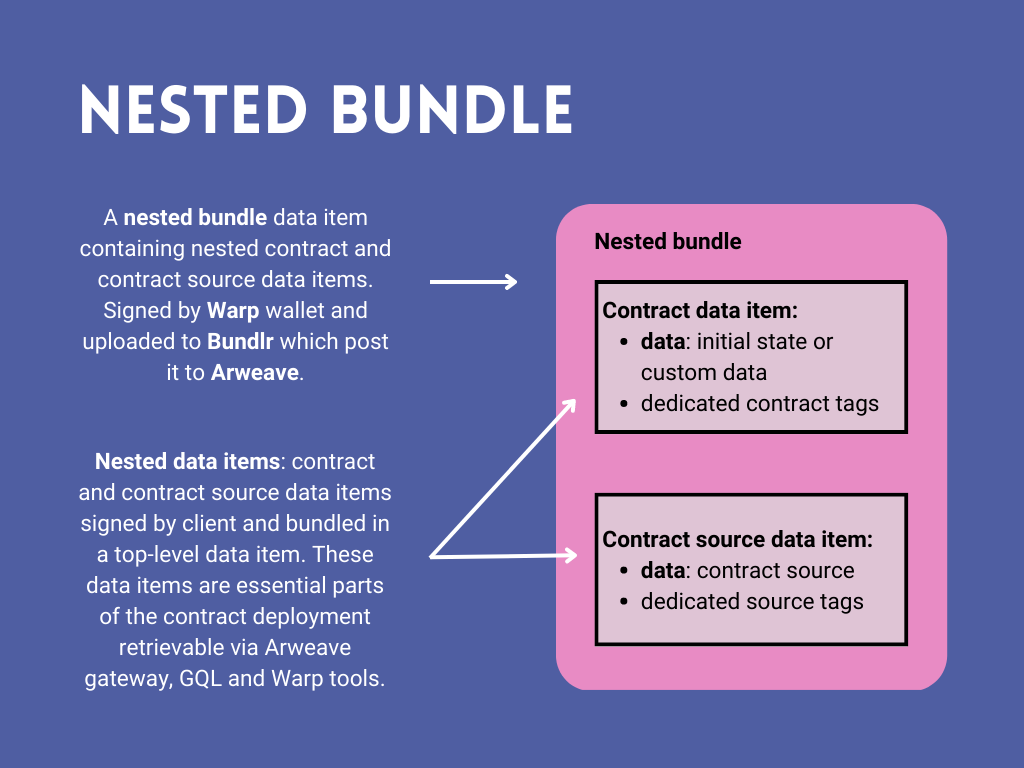Warp Bundled Contract Format
This document describes the core concepts behind the Warp bundled contract format.
Introduction
The idea behind Warp Bundled Contract Format is to increase the Developer and User Experience.
Normally, when a contract is being deployed on Arweave, one has to wait some time:
- for the contract's transactions mining (~2 minutes)
- for the proper contract's transactions confirmation (assuming at least 10 blocks - ~20 minutes)
This in total gives ~20-25 minutes, which:
- Breaks the DX, e.g. in case developer wants to quickly test the new contract version on Arweave mainnet
- Breaks the UX, e.g. if given protocol deploys the contracts dynamically - e.g. via GUI (e.g. deploying NFT collections, connecting deployed data with access rights, etc.)
Additionally, deploying contracts requires some amount of ARs in the wallet - which might further increase the entry barrier, both for developers and given protocol users.
Advantages of using Warp Gateway for contracts deployment
- Contract is instantly available - as soon as proper response from Bundlr network is received.
- Contract deployment does not require any ARs in the wallet - the deployment via Bundlr network is either fully subsidized by the Arweave (for transactions <= 100KiB) or by the Warp (for transactions > 100KiB). The max transaction size is currently 2MiB.
- Even though the Bundlr transactions are created and signed by the Warp's wallet, it is still possible to identify the original transaction owner/signer.
How it works
Nested bundles
Bundling allows to write multiple data items into one top level transaction. A data item differs from a regular transaction by not allowing to transfer AR tokens and passing reward but it has most of the transaction's properties - such as owner, data, tags, owner and id.
In a nutshell, the nested bundles concept means that such data item of a bundle can also be a bundle containg other data items. According to ANS-104 standard it can lead to theoretically unbounded levels of nesting.
You can read the specification for nested bundles standard in ANS-104.
Warp Gateway
Instead of posting the contract and contract source transactions directly to Arweave mainnet, Warp Plugin creates data items from either both of them (when using deploy method) or only contract (when using deployFromSourceTx method) and send them to Warp Gateway where they are wrapped in a nested bundled and uploaded to Bundlr.
Bundling contract is the default behaviour of Warp's SDK warp.deploy function, when forMainnet instance is being used.
The Warp Gateway uses nested bundle concept to deploy contract and contract source to Arweave:

The validity and tags of the data items are verified.
Data items are wrapped in a bundle:
const bundle = await bundleData([dataItem]);
- Another data item - a nested bundle containg our contract or contract source data item - is created:
const bundlrTx = bundlr.createTransaction(bundle.getRaw(), tags);
A nested bundle contains following tags:
{ name: 'Bundle-Format', value: 'binary' },
{ name: 'Bundle-Version', value: '2.0.0' },
{ name: 'App-Name', value: 'Warp' },
{ name: 'Action', value: 'WarpContractDeployment' }
- Our nested bundle is signed and uploaded to Bundlr which then post it to Arweave:
await bundlrTx.sign();
const bundlrResponse = await bundlr.uploader.uploadTransaction(bundlrTx, { getReceiptSignature: true });
After receiving proper response and receipt from Bundlr, the Warp gateway indexes the contract transactions data internally - to make them instantly available.
Finally, the Warp gateway returns an object as a
response- that consists of fields:
response.contractTxId- contract idresponse.srcTxId- contract source idresponse.bundlrTxId- id of the nested bundle containing contract and contract source data items
Resulting transaction structure
This is how the example contract o0SKH5SER-pJa50rxB891ZoumWdt8PBindQAtvhbeYw looks like on ViewBlock.
Keep in mind that it takes some time before Bundlr posts given bundle to Arweave and ViewBlock actually index such bundle and its contents - usually it may take 1-2 days.
- The
o0SKH5SER-pJa50rxB891ZoumWdt8PBindQAtvhbeYwis the id of the contract data item - according to ANS-104 specs. - The
gZYT07AIXZ9oQ0xkUIJC6IMVYh82prapK-VS34h_G30is the id of the Arweave nested bundle transaction - that contains a data item from point 1, according to ANS-104 specs
The first data item is effectively important from the SmartWeave protocol perspective - it is the transaction that the protocol 'sees' when it loads the contract.
Contract transaction retrieval via Arweave gateway
Arweave gateway, using
response.contractTxId: https://arweave.net/o0SKH5SER-pJa50rxB891ZoumWdt8PBindQAtvhbeYwArweave GQL:, using
response.contractTxId
query {
transactions(
ids: ["o0SKH5SER-pJa50rxB891ZoumWdt8PBindQAtvhbeYw ]
) {
edges {
node {
id
tags {
name
value
}
block {
height
}
}
}
}
}
Example Response:
{
"data": {
"transactions": {
"edges": [
{
"node": {
"id": "o0SKH5SER-pJa50rxB891ZoumWdt8PBindQAtvhbeYw",
"tags": [
{
"name": "App-Name",
"value": "SmartWeaveContract"
},
{
"name": "App-Version",
"value": "0.3.0"
},
{
"name": "Contract-Src",
"value": "rOjueBWSZOIBEtm9hAO3h2INlEJvCMneUp76R_cYFgo"
},
{
"name": "SDK",
"value": "Warp"
},
{
"name": "Nonce",
"value": "1676981079385"
},
{
"name": "Content-Type",
"value": "application/json"
}
],
"block": {
"height": 1123534
}
}
}
]
}
}
}
Contract transaction retrieval via Warp gateway
The Warp /gateway/contract endpoint allows to retrieve contract via response.contractTxId.
This endpoint is used by default for loading contracts data by the Warp SDK - when forMainnet instance is being used.